The ‘punching fists of democracy’: How the West’s new tanks could give Ukraine a battlefield edge over Russia
Further battalions of Leopard, Abrams and Challenger tanks could eventually be a game-changer, Andy Gregory reports

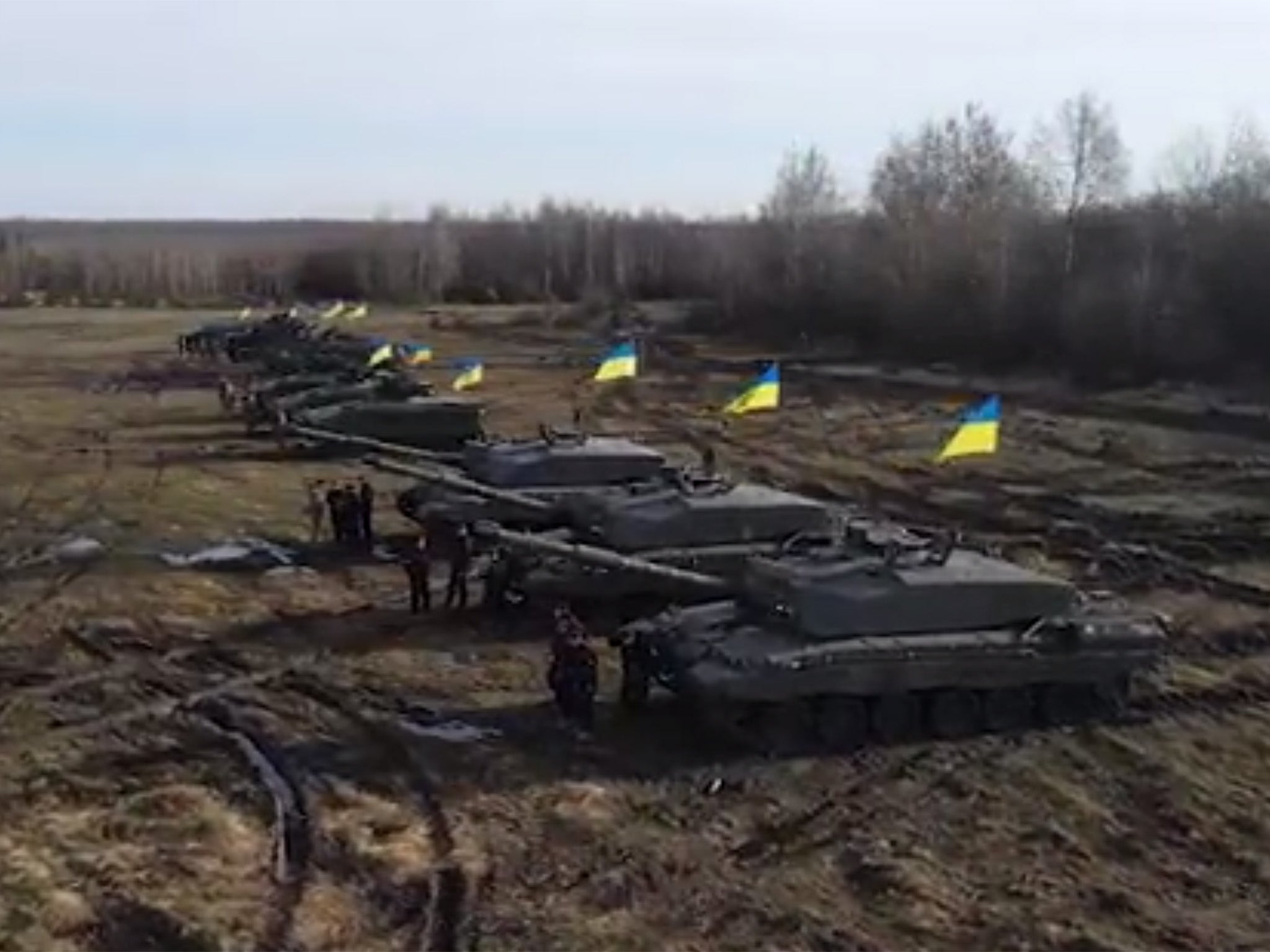
It was a decision hailed by a top aide to Ukraine’s President Volodymyr Zelensky as “a real punching fist of democracy” against Russia’s invasion – the fact that the UK, US and Germany would provide tanks to Kyiv.
The 14 Challenger 2 tanks from Britain and 18 Leopard 2 tanks pledged by Germany have now reached Ukraine. The country’s defence minister, Oleksii Reznikov, gave the UK the thumbs up as he took a ride in one of the tanks. Mr Reznikov wrote on Twitter that the tanks had "recently arrived in our country" and posted a video that showed him sitting in one of a long line of tanks in an open field, all of them flying Ukraine's yellow and blue flag.
"It was a pleasure to take the first Ukrainian Challenger 2 MBT (main battle tank) for a spin," Mr Reznikov wrote. "These fantastic machines will soon begin their combat missions." In the video, he gave the thumbs up sign and thanked British Defence Secretary Ben Wallace for the tanks.
"Marvellous, Ben," he said in English. "It's...very good stuff. Thank you very much from Ukraine to the United Kingdom."
As for the tanks from Germany, the country’s defence minister, Boris Pistorius said on Twitter: "I'm sure that they can make a decisive contribution on the front."
While unlikely to turn the tide of the war in their current numbers, the roughly three battalions’ worth mark a gear change in Nato’s support for Kyiv – as underscored by the Kremlin’s accusations of direct Western involvement and a renewed flurry of nuclear threats from Vladimir Putin’s inner circle.
The tanks themselves – including US M1 Abrams – are generally viewed as more potent than most of the Soviet and Russian-made vehicles which, to the surprise of those who believed tanks to be practically defunct, have so far played a central role in Europe’s largest land war in decades.
While long-range artillery systems and drones have also proved critical in the conflict, Kyiv will be hoping that further deliveries of tanks will help to give Ukraine the edge on the battlefield.
The Independent has taken a look at the various tanks either already, or soon to be, at play in the war, how they compare, and what this could mean for the war effort on each side.
Challenger 2
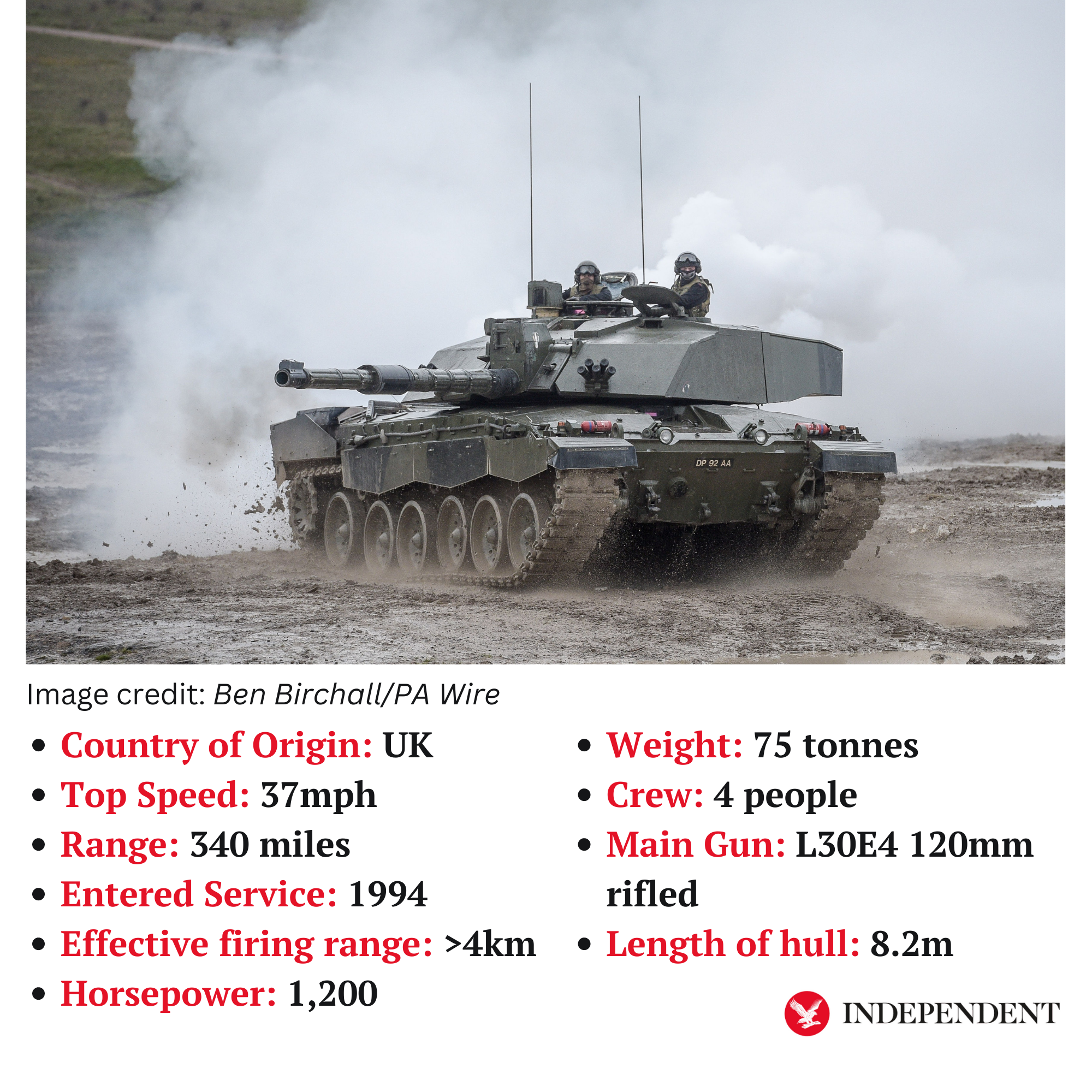
The UK has sent 14 of its Challenger 2 tanks to Ukraine.
Developed by Vickers Defence Systems, now BAE Systems, these 8.3-metre-long tanks have since been deployed in Bosnia, Kosovo and Iraq, and are designed to destroy other tanks. The British army claims it has “never experienced a loss at the hands of the enemy”.
It is the heaviest of all three Western tanks on offer, and although capable of firing Nato rounds, uses a different kind of ammunition for its main rifled gun – high-explosive squash-head ammo – and is slightly slower, sporting a 1200-horsepower engine, 300 short of its contemporaries, according to Dr Miron.
Its 120mm rifled gun is said to have an effective firing range of at least 3km using armour-piercing rounds. The Challenger also claims the furthest tank-on-tank kill shot in military history, destroying an Iraqi vehicle at a range of 4,700 metres during the Gulf War in 1991.
This tank prioritises firepower and protection – provided by “world-class” Dorchester 2 armour – over speed, making it slightly slower than its counterparts, but this is offset by its “accuracy and lethality”, according to the British army.
“As far as protection goes, Challenger 2 is very well protected. It would take a number of hits from a T-72 [Soviet-era tank operated by Russia] and the crew would survive,” Mr de Bretton-Gordon previously said.
Leopard 2
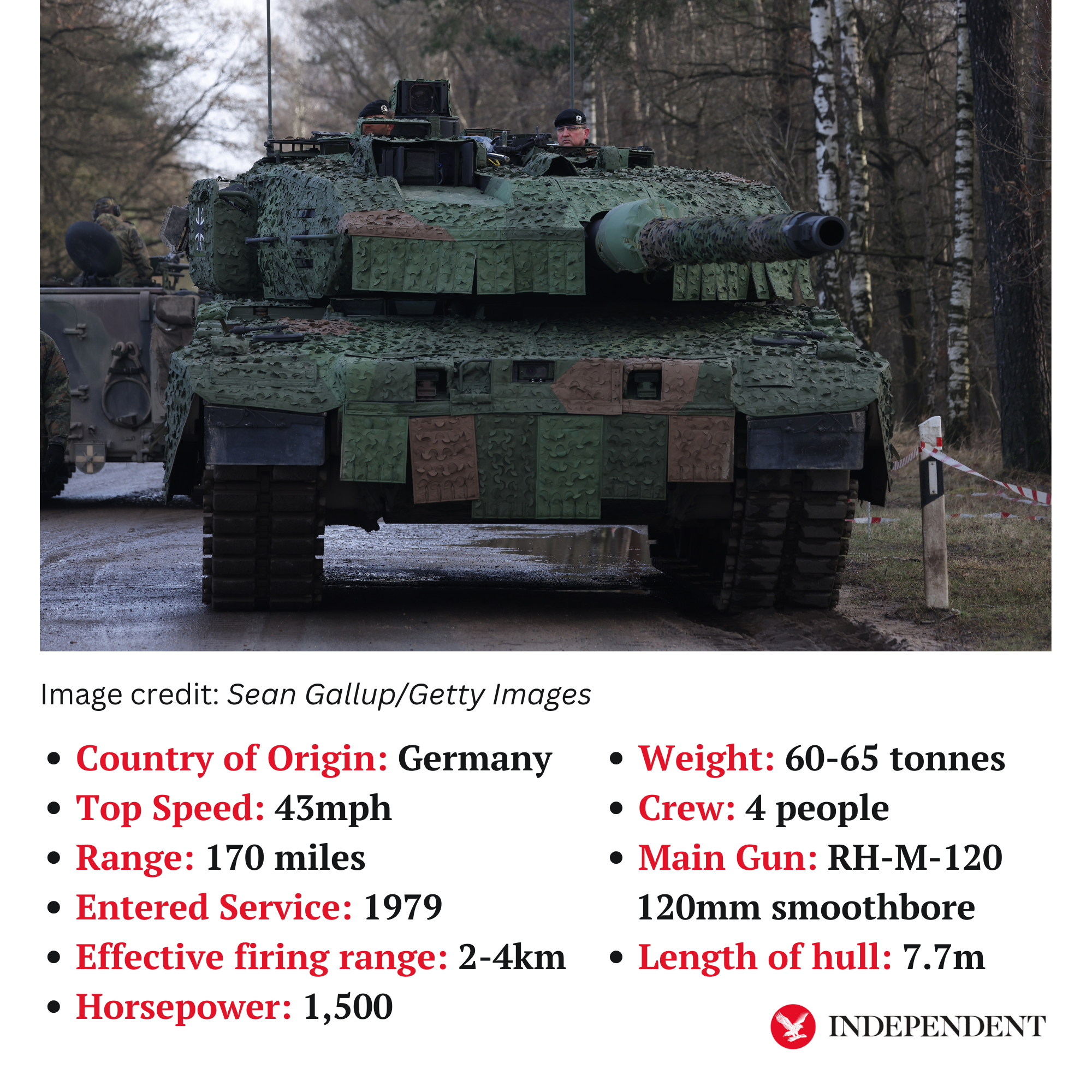
More than 2,000 Leopard 2s sit in European and Canadian arsenals, with a reported price tag of around £5m each.
Designed during the Cold War, as part of a programme that also birthed the Abrams, to fight the Soviet-era tanks currently being used in Ukraine, Leopards are designed to withstand 125mm penetrator ammunition fired from 1,500 metres and “are one of the best armoured tanks”, according to Dr Marina Miron, of Kings College London’s war studies department.
Fitted with two coaxial light machine guns alongside its main guns, the Leopard is prized for its high manoeuvrability and adaptability, and is viewed as particularly suitable for Ukraine, with relatively lower fuel consumption than its American counterpart.
“These are the Mercedes BMW supertanks of the world,” Hamish de Bretton-Gordon, a former commanding officer in the British army’s Royal Tank Regiment, told CBS News, adding: “I would want at least 10 or 15 T-72 survivors [used by Russia] up against one of them.”
M1A2 Abrams
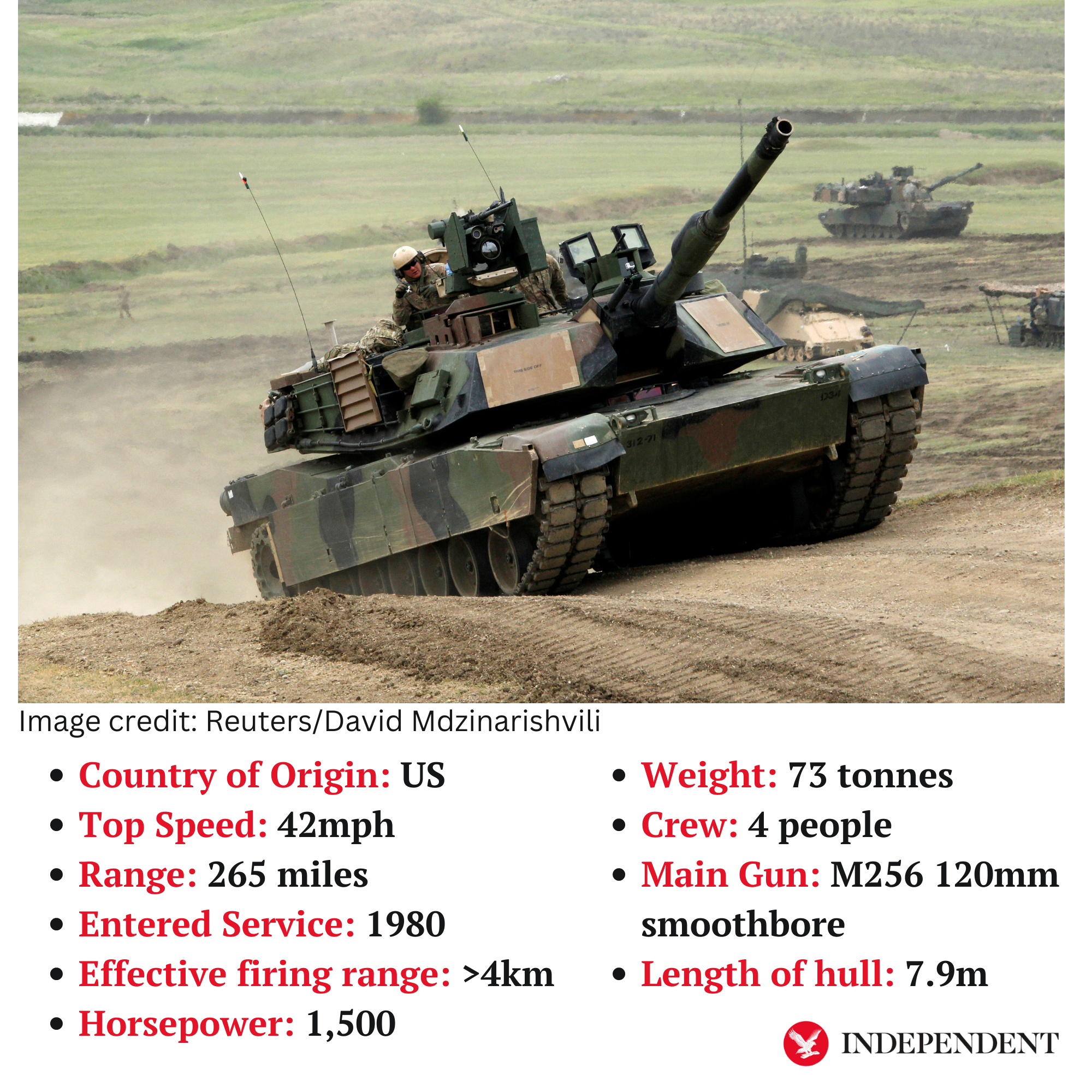
Designed by Chrysler Defence during the Cold War and since used in Bosnia, Iraq and Afghanistan, the Abrams is the main battle tank of the US army, while Australia, Saudi Arabia, Egypt and Poland all own export versions. Ukraine is now set to receive 31 of the tanks – enough for an entire battalion.
The Abrams is reported to be the first tank in which the commander and gunner are both provided with optical and thermal sights – including a periscope spanning 360 degrees – which allows them to simultaneously track separate targets in what is called a “hunter-killer” capability.
The US army credits the tank – reported to cost up to $10m (£8.06m) once training and maintenance is factored in – with “lethal firepower, unparalleled survivability, and audacious manoeuvre”, while Dr Miron told The Independent that the 120mm depleted uranium rounds it fires, known as “silver bullets”, are “probably the most lethal to any armour”.
The “main difference” between the Abrams and the Leopard lies in the former’s gas turbine engine, which requires jet fuel, meaning troops would need a separate supply chain to power the vehicles, according to Dr Miron – and American officials have long expressed doubts over its suitability for Ukraine.
“The maintenance and the high cost that it would take to maintain an Abrams — it just doesn’t make sense to provide that to the Ukrainians at this moment,” the Pentagon said as recently as last week.
Yet, following president Joe Biden’s volte-face this week, reports suggest that while Washington will send 31 of the more advanced M1A2 tanks – as opposed to the older M1A1 models – federal policy means that they will be stripped of their classified armour, which includes depleted uranium, probably because of fears that the tanks could be captured by Russia on the battlefield.
T-72
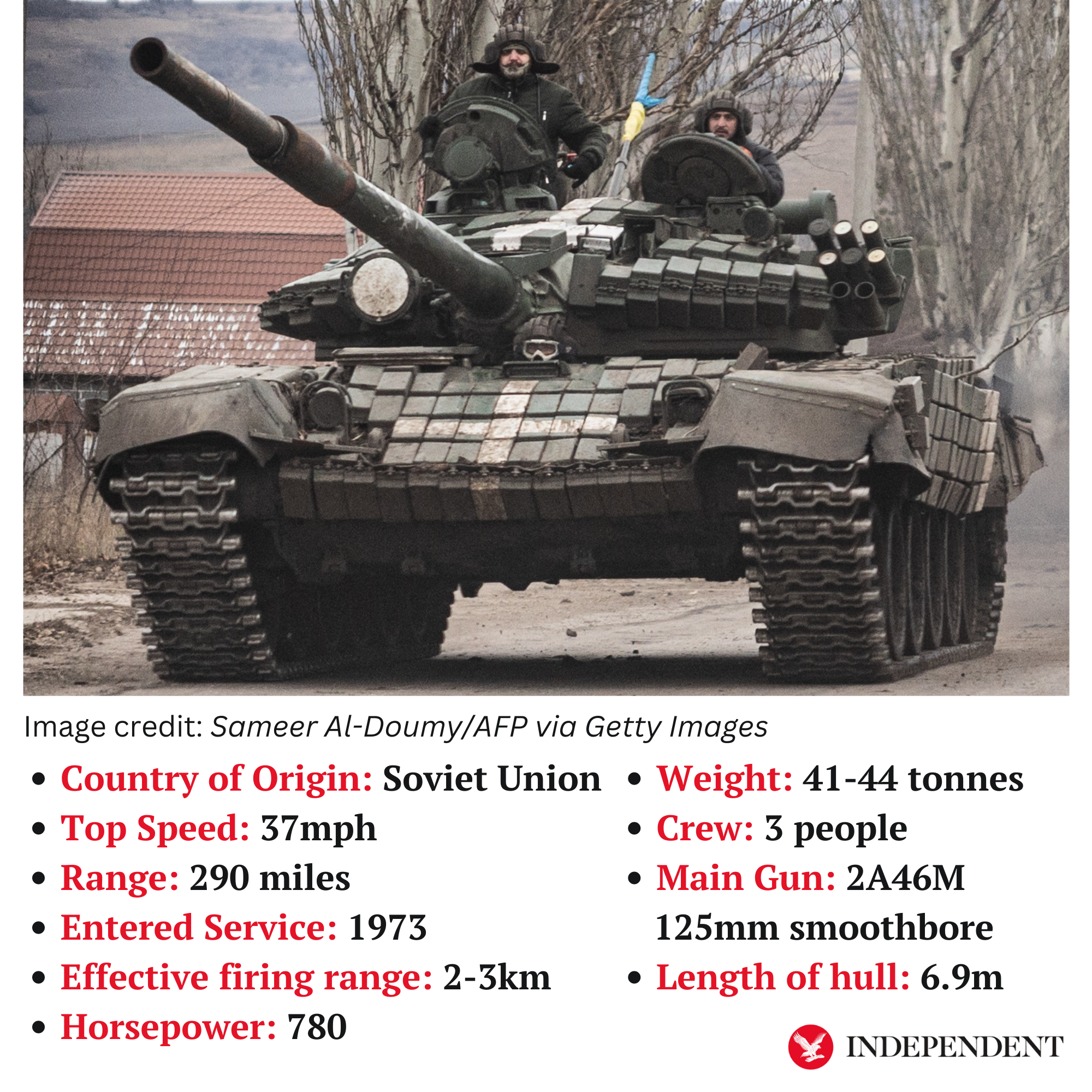
Both Ukraine and Russia have been relying heavily on Soviet-era T-72 tanks, which despite representing a new level of firepower upon their introduction in 1973 – with their large 125mm cannons – now find themselves somewhat outgunned by the next generation.
Upgraded versions are said to have a limited “hunter-killer” capability, but lack the panoramic sight enjoyed by the commander in newer tanks. Like other models on this list, most T-72s are also fitted with a laser rangefinder, which adjusts the main gun before it fires in order to account for wind, temperature and the tank’s movement.
As the Red Army’s main tank until the Soviet Union’s collapse, tens of thousands of these lightweight and relatively agile models are believed to have been produced, with Wired reporting in 2015 that used models could be bought by civilians for just $50,000.
These are the main tanks currently used by Ukraine, which also uses Soviet T-64s and T-80s, and account for most of the 450 tanks Kyiv has been supplied with by its allies since Russia’s invasion last February, given its existing familiarity with the vehicles.
But in terms of its armour, the T-72 is quite “light”, mainly using welded steel, meaning that the crew protection element “is certainly much weaker than other tanks”, according to Dr Miron – evidenced by the continual flow of images showing these tanks with their turrets blown off.
Washington has pledged to upgrade some of Kyiv’s stock of T-72s with new optics, communications, and armour, which the Pentagon claimed would make them “the most technically advanced tanks on the battlefield”.
T90
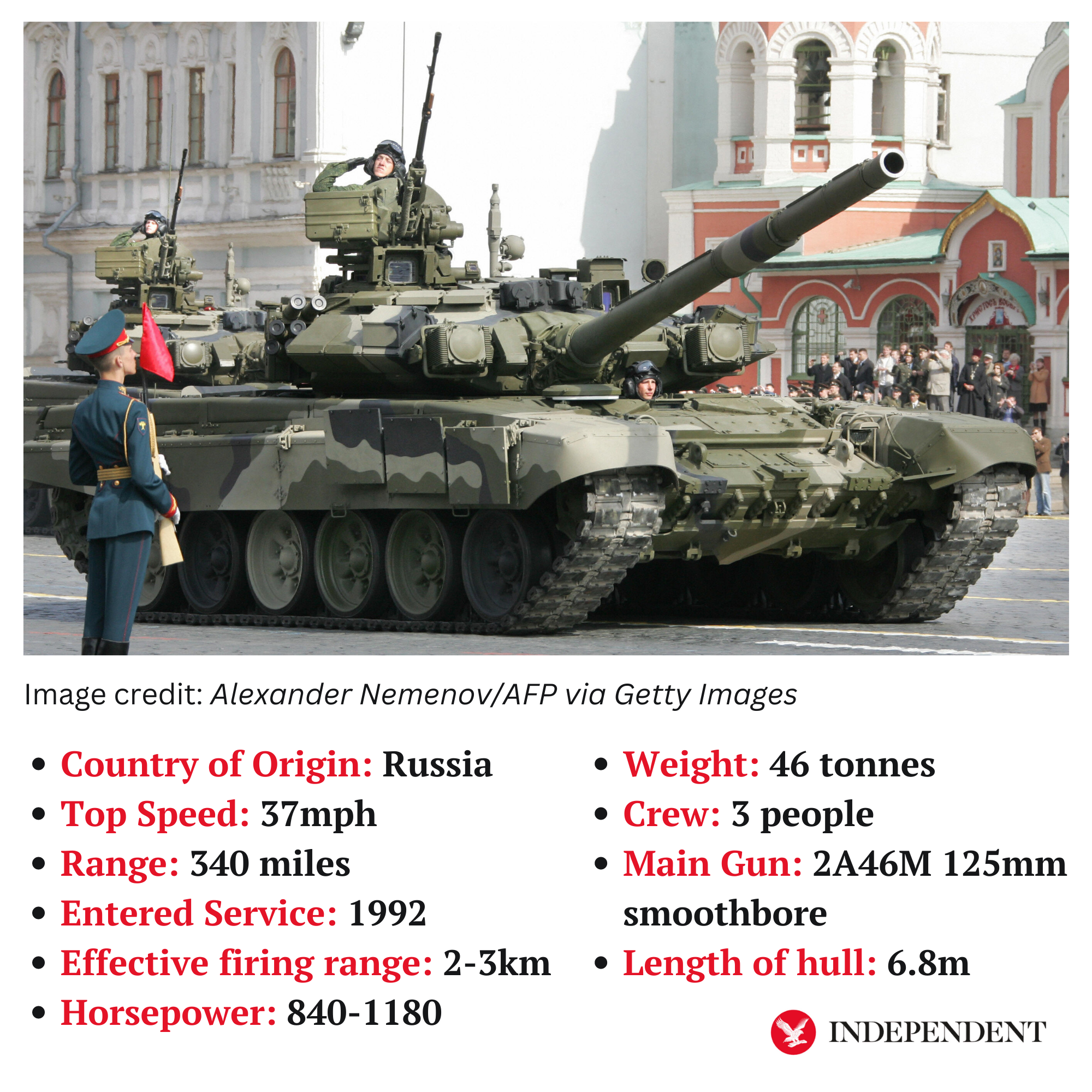
Designed by Russia as an improvement on its Soviet predecessors, following heavy losses during the Chechen and Gulf wars, some versions of Moscow’s newest tank are, on paper at least, even better than their Nato counterparts, boasting a superior gun and anti-tank missile system.
The T90’s large 125mm gun can fire different types of ammo, including HEAT and HE-Frag (high-explosive fragmentation) ammo, as well as the 9M119 Reflex (Refleks) anti-tank guided missiles, which have a maximum range of up to 4,000m, according to Dr Miron.
The T-90S model boasts both conventional and explosive reactive armour, and along with its Western counterparts has some modern detection systems such as infrared, thermal vision, and day and night sight, Dr Miron said.
But Britain’s Ministry of Defence said in August that it was “highly likely” that many Russian crews lacked the training to properly maintain explosive reactive armour – as it sought to account for the “heavy attrition” suffered by Russia’s main battle tanks in Ukraine.
According to the Military Balance database, Russia had around 3,330 operational tanks in total shortly before its invasion of Ukraine, with another 10,000 in storage.
For its part, Ukraine is thought to have started the war with just shy of 1,000 Soviet-made T-64s, T-72s and T-80s.
T-14 Armata
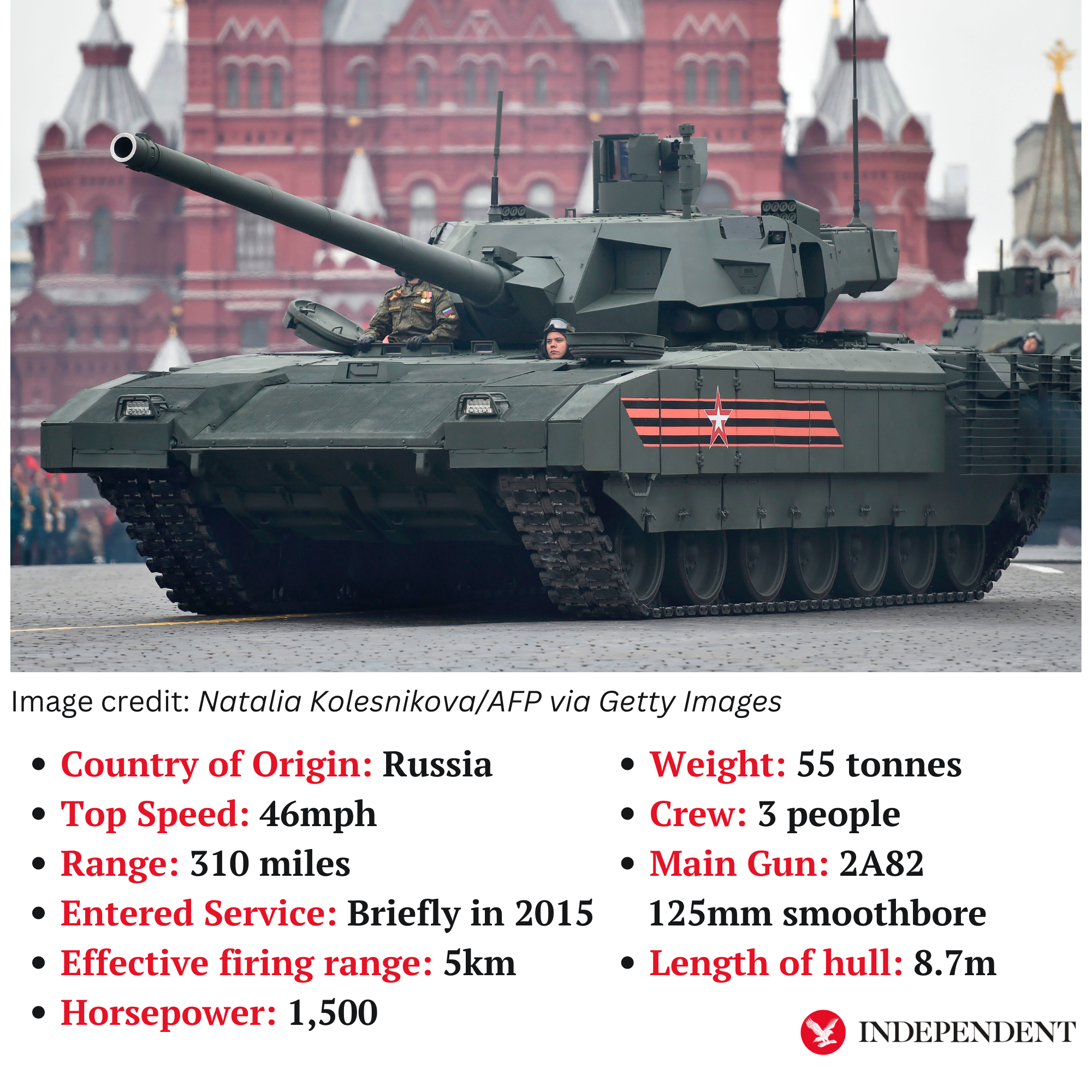
Recent reports have claimed that Moscow is preparing to deploy its most advanced T-14 Armata tanks in Ukraine.
First revealed during the 2015 Victory Day parade, this tank has been described as marking an ambitious departure from its pragmatic and cost-efficient predecessors. It is claimed to be capable of firing guided anti-tank missiles with a range of 5km, potentially putting low-flying helicopters at risk.
The fastest of the tanks listed, its armour has been updated to a combination of steel, ceramic, and composite materials, with the potential for further modules to be added on, and is claimed to be invulnerable even to RPGs and to nuclear, chemical and biological weapons, according to Dr Miron.
However, the British Ministry of Defence has suggested that its deployment is “likely to be a high-risk decision for Russia”, with its 11-year development programme “dogged with delays, reduction in planned fleet size, and reports of manufacturing problems”.
Having already been hampered by logistics issues in Ukraine’s vast territory, Moscow could struggle to adapt its supply chains to incorporate these larger and heavier tanks, according to the ministry.
Therefore, any deployment would likely be primarily “for propaganda purposes”, with production probably only in the low tens, and commanders “unlikely to trust the vehicle in combat”, British intelligence analysts said.
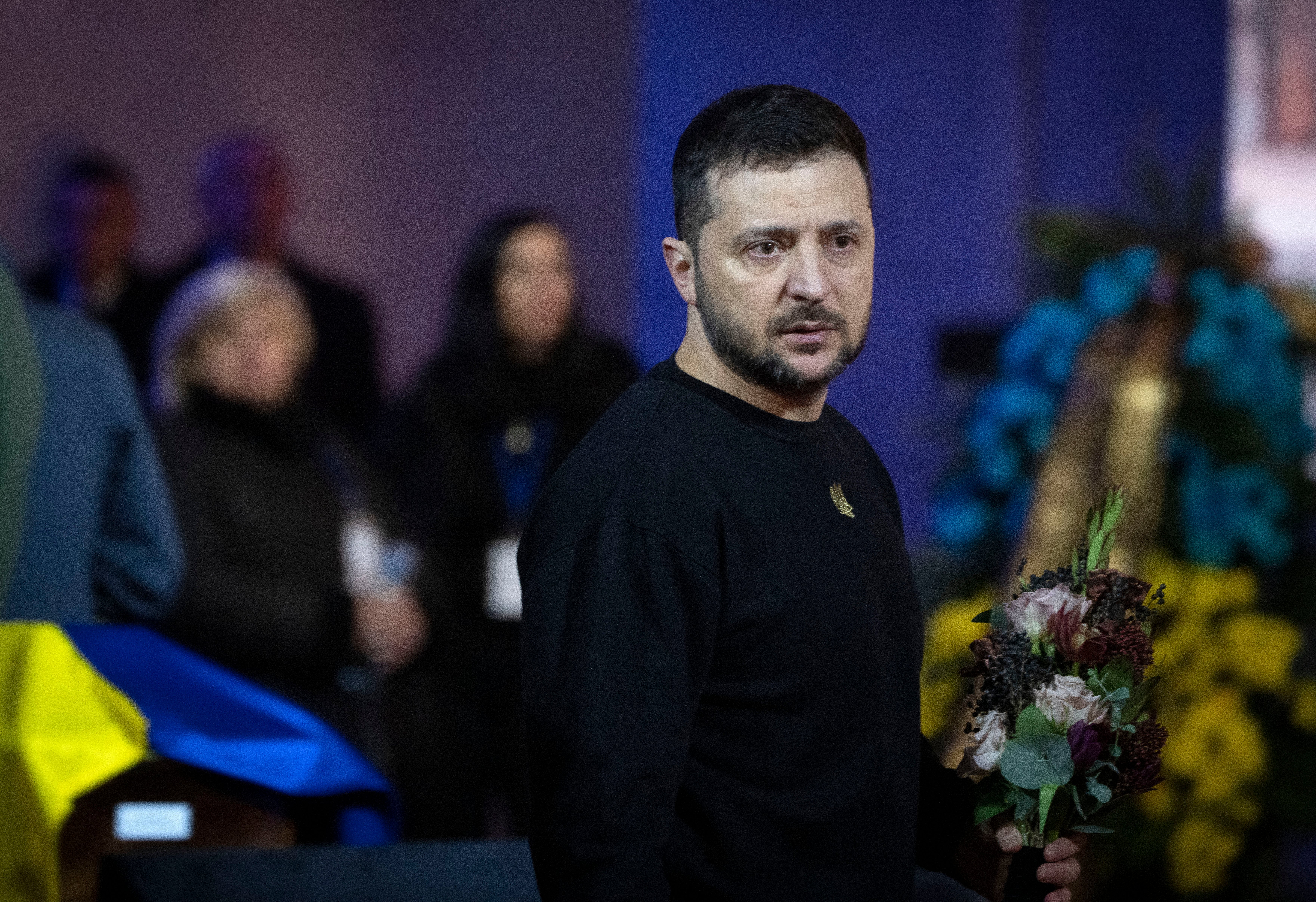
What does this mean for the Ukraine war?
All three Western tanks are more agile than Russia’s T-models, which can’t reverse at speed, said Ralf Raths, director of the Panzer Museum in Munster, Germany.
“Imagine a boxer who cannot move freely in the ring, but only in one direction,” he explained. “The other boxer, who can move in all directions, has a big advantage, and that is the case with the Leopards.”
Were both sides to have similar numbers of tanks – not yet a prospect – such vehicles could give Ukraine the upper hand, Dr Raths said, adding: “The Ukrainians shine through creative, dynamic, and often very clean warfare. So it could well be that if Ukraine’s operational offensive were to begin, the Russians would have real problems countering it.”
However, Dr Miron also warned that neither the Challenger nor the Leopard has seen many battles and, despite its seemingly superior armour, the Leopard “has seen some problems in Syria and proved to be vulnerable to mortars and mines”.
But after months of brutal attrition on the front lines, such tanks could allow Ukraine to go on the offensive, according to Yohann Michel of the International Institute for Strategic Studies, who said: “In this type of conflict, it’s just not possible to carry out large-scale offensives without the full variety of armoured combat equipment and armoured vehicles, and tanks are a part of that.”
Niklas Masuhr, of the Zurich-based Centre for Security Studies, warned that the addition of Leopards alone wouldn’t be “a game changer or a war-winning technology, anything like that”.
“You can’t just deploy a bunch of main battle tanks and assume they will win,” he said. “They’re very valuable, but you still need to use them in the correct way and integrate them with all the other military tools that you have at your disposal.”
Join our commenting forum
Join thought-provoking conversations, follow other Independent readers and see their replies
Comments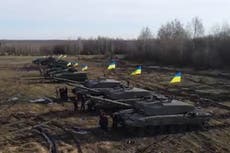




Bookmark popover
Removed from bookmarks